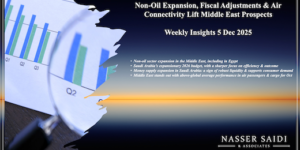Markets
Global equity markets fell sharply last week shedding USD 2.2tn in market cap due to 3 factors: 1) the reaction to escalating trade wars; 2) the damaging revelations on Facebook’s dubious practices on users’ personal data and 3) the normalization of monetary policy in the US. The S&P500 dropped 6% and it is close to the level last seen in mid-November. Most other major bourses recorded heavy losses, even in emerging markets, although regional markets managed to contain the debacle and KSA actually advanced substantially with a rise in oil prices. In currency markets, the dollar failed to benefit from the Fed’s move, while the yen was supported by a safe haven effect. Oil prices were again on the rise due to supply disruptions in Venezuela and a 2.6 m/b drop in US crude inventories compared to predictions of a 3.2 m/b increase. After weeks of lackluster performance, gold prices regained ground as a consequence of the equity markets’ rout.
Global Developments
US/Americas:
- Despite a threat to veto a bipartisan spending bill, President Trump averted a government shutdown by agreeing to a federal budget spending by USD 1.3tn. This will ensure the government remains funded through to the end of Sep.
- President Trump signed a memorandum to impose 25% tariffs on up to USD 60bn worth of Chinese imported items to be specified within 15 days. China has announced retaliation on US products worth about USD 3 bn if it cannot reach an agreement with the US.
- As expected, the US Fed raised the federal funds target rate range to 1.5-1.75% foreseeing stronger inflation pressure. The main surprise were the revision to GDP growth from 2.5% to 2.7% for 2018 and from 2.1% to 2.4% for 2019. The Fed also expects lower unemployment (3.6% in 2 years) and confirmed its mildly hawkish stance ventilating 2 additional rate hikes in 2018 and 3 in 2019.
- The IHS Markit US Composite PMI declined to 54.3 in Mar from 55.8 in Feb. Private sector output however remains buoyant thanks to perky rises in both manufacturing production (55.7 vs 55.3 in Feb) and services activity (54.1 vs 55.9 in Feb). Employment expanded at a pace not seen since May 2015.
- US existing-home sales in Feb increased by 3% mom (1.1% yoy) after 2 months of decline, thanks to single-family sales, while condo/co-op sales fell substantially. New-home sales in Feb dropped -0.6% mom (+0.5% yoy) after -4.7% mom in Jan.
- The US current account deficit widened to USD 128.2bn in Q4 from USD 101.5bn in Q3, the largest deficit since 2008, due largely to a USD 19bn increase in the goods deficit.
- New orders for US durable manufactured goods surged 3.1% mom in Feb recovering from a -3.5% plunge in Jan. The volatility was due to nondefense aircraft orders which shot up 25.5% mom, but the gains were broad based. Orders of core capital goods rose 1.8% mom. Ex transport goods the index advanced 1.2% mom.
- US initial claims for unemployment benefits rose 3,000 to 229,000; the 4-week moving average rose 2,250 to 223,750. Continuing claims fell sharply by 57,000 to 1.828 mn.
- The US Conference Board’s Leading Indicators Index rose 0.6% in Feb adding to a strong 0.8% increase in Jan. Most components displayed positive contributions, the exceptions being building permits and stock prices.
- The Central Bank of Brazil reduced the Selic rate by 25 bp to 6.5%, as inflation stands well below target.
Europe:
- The European Council meeting approved some terms of the Brexit, including a 21-month transition period after Mar 2019 which removes the risk of a “hard-Brexit”.
- The IHS Markit Manufacturing PMI for the Eurozone fell to 56.6 in Mar from 58.6 in Feb, marking the lowest point since Jul. Output growth was the weakest in more than a year and new export orders rose the least since Nov 2016. Expectations of future output growth was at a 15 months low.
- The Eurozone’s trade surplus plunged to EUR 3.3bn in Jan from EUR 25.4bn in Dec, but was quite buoyant compared to a deficit of EUR 1.4bn in Jan 2017, as yearly export growth exceeded imports growth.
- The German Ifo Business Climate Index fell by 0.7 to 114.7 in Mar, the lowest reading since last Apr, The current conditions index dropped by 0.5 points to 125.9 and future expectations declined 1 point to 104.4. This is hardly a dramatic change, just a little pause for the German economy.
- Italy’s industrial production in Jan plunged -1.9% mom after three months of gains including the 1.6% surge in Dec. Part of the drop was caused by a -7% mom contraction in electricity production due to mild weather, but most manufacturing sectors displayed weak performances.
- The Bank of England kept rates unchanged at 0.5% but signalled that a hike will come in May.
- UK inflation retreated to 2.7% yoy in Feb from 3% in Jan (0.2% below the MPC expectations). Prices cooled in all sub-indices but the main factor was a drop in transport services after the end of the oil price one-off base effect. Core inflation also declined by 0.3% to 2.4% yoy in Feb.
- The UK unemployment rate edged lower to 4.3% in the 3 months to Jan from 4.4% in Q4.
- UK retail sales went up only 1.5% yoy in Feb, the same rate as in Jan, despite a 0.8% mom rise, which was not enough to reverse declines in Dec and Jan. In essence private spending remains on a weak trend.
- The Central Bank of Russia cut its interest rate by 25 bp to 7.5% on lower inflation.
Asia Pacific:
- China’s central bank followed the Fed’s hike but increased its key rate by just 5 bp to 2.55%. This marks the first, unsurprising, major policy move by the new Governor Yi Gang.
- Japan’s trade surplus shrunk to JPY 3bn in Feb from JPY 805bn a year earlier. Imports jumped 16.5% to JPY 6,460bn, while exports rose only 1.8% to JPY 6,463 bn.
- The Nikkei Japan Flash Manufacturing PMI dropped to 53.2 in Mar, compared to 54.1 in Feb, as new orders rose the least in 5 months, employment increased at the slowest pace since Jul 2017 and output growth stalled.
- Inflation in Japan increased by 0.1% mom (1.5% mom) in Feb down from 0.4% (1.4% yoy) in Jan. Annual core inflation also increased by one decimal to 1%.
Bottom line: The new Fed Chairman Jay Powell signaled continuity in his debut policy meeting reiterating the message of his predecessor and refraining from any surprising statement that could unsettle markets or trigger a political controversy. He avoided any hint of aggressive moves, dismissing the Fed’s higher median interest rate forecasts and stressing the uncertainties over the medium term outlook. This tense honeymoon with markets is unlikely to last indefinitely, as the normalization of monetary policy inevitably will mop up the abundant liquidity which has fueled the equity rally. On the macro front, PMI figures picked up some malaise in the largest developed economies. It is hardly worrisome, nevertheless it suggests that the global rebound is probably close to its plateau.
Regional Developments
- Bahrain initiated investor meetings late last week, ahead of the potential dollar bond sale; the country is targeting a seven-year Sukuk, a 12-year conventional bond and/or a 30-year conventional bond.
- Bahrain’s port operator confirmed plans for an IPO by end of this year: the Khalifa Bin Salman Port plans to offer 20% of its total equity, but no pricing has yet been finalised.
- Work has begun in northern Bahraini waters for the USD 670mn submarine gas pipeline: the 5km pipeline, which will be completed this year, will store liquefied gas to import and for conversion.
- Egypt expects growth to remain around 5.3-5.4% in Q3 of the financial year 2017-18, disclosed the finance minister, in line with Q2’s reading of 5.3%.
- Egypt’s government approved its 2018-19 fiscal year budget last week: the budget is estimated to post a deficit of 8.4% of GDP and the targeted GDP growth is 5.8%.
- Non-performing loans in Egypt fell to 4.9% of total loans at end-Dec 2017, from 5.3% in Sep 2017. According to the central bank, NPLs accounted for 3.4% of total loans in the top 10 banks, while the ratio touched 2.9% among the top five banks in the country.
- Egypt disclosed the names of 23 state companies that have plans to sell stakes ranging from 15-30% (starting from this year till the next 2-2.5 years). This includes Banque Du Caire, one of the largest banks, major oil companies Middle East Oil Refining and Engineering for Petroleum and Process Industries, as well as Misr Insurance Company. The aim is to raise EGP 80bn (USD 4.6bn) through minority share offerings on the Cairo exchange.
- Egypt’s Suez Canal reported a decline in revenues to USD 435.8mn in Feb from Jan’s USD 451.9mn.
- Jordan expects net direct foreign investments to grow by 12% to JOD 1.38bn this year; foreign investments are estimated to have increased by 12.1% yoy to JOD 1.238bn in 2017, according to the central bank.
- Jordan’s finance minister revealed that the government expects to borrow JOD 785mn ($1.1 bn) this year to finance the budget deficit as well as the Water Authority of Jordan’s debts to local lenders.
- Kuwait has set 2028 as the deadline for complete Kuwaitization of jobs in the public sector, reported the Al Rai
- The Ministry of Finance in Kuwait has postponed VAT preparations in the country until the National Assembly approves VAT, reported the Al Qabas Even if the VAT law is approved this year, it is unlikely to be implemented before 2020, as technical and administrative preparations will take at least a year.
- Kuwait’s bill raising residency fees for expatriates is in its final stage, revealed a senior government official. The Residency Affairs Department has recommended a 50-100% hike in the charges of all services offered by the department.
- Kuwait plans to build a USD 6.6bn industrial city: the project, which will include residential and leisure projects in addition to industrial facilities, is expected to complete infrastructure work (at an estimated cost of USD 600mn) by 2021.
- Lebanon plans an issue of special bonds to raise USD 700mn local funding – probably after the budget is approved and before the May elections – according to a senior adviser to the PM. This will help unlock an additional USD 4bn in international funding for infrastructure projects.
- Lebanon’s foreign currency reserves are above USD 43bn, according to the central bank governor; reserves were up by USD 1.4bn in Jan-Feb this year, helped by higher Lebanese pound interest rates.
- Qatar left its repo rate unchanged at 2.5%, but raised its overnight deposit rate by 25bps to 1.75%.
- Inflation in Saudi Arabia edged down marginally to 2.9% yoy in Feb from Jan’s 3%; food and beverages prices were up 6.5% yoy, transport costs up 10.1%, but the household and utilities sector reported a rise of only 1.3%. Prices of clothing and footwear plunged 8%, largely the result of heavy discounting by retailers.
- Saudi Arabia sold SAR 4.85bn (USD 1.29bn) of domestic Sukuk in a monthly sale, according to the finance ministry; this compares to the SAR 7.22bn of domestic Sukuk sold last month.
- Saudi Arabia’s General Authority for Zakat and Tax registered 3,542 value-added tax violations in the first two months of implementation. These violations include eligible businesses not registering for VAT, charging a rate higher than 5%, not including the VAT identification number and also issuing invoices without the necessary VAT information.
- Saudi Arabia’s central bank has instructed banks to modify the loan-deposit ratio starting early April – giving greater weight to long-term deposits to facilitate more lending. The Maaal financial news website reported that a weighting system would be introduced for calculating bank’s deposits ranging from 100% for the face value of deposits on demand to 190% for deposits of over five years. The maximum loan-to-deposit ratio for commercial banks will continue to remain at 90%.
- First Abu Dhabi Bank – the UAE’s largest bank – has been granted commercial banking license in Saudi Arabia; the license allows the bank to operate up to three branches across the country.
- The volume of US investments in Saudi Arabia surpassed SAR 207bn ($55bn) till Feb 2018 from some 373 US companies, according to a SAGIA report. Industrial activities account for bulk of the investments (SAR 193bn for 95 projects), followed by the services sector (SAR 13.5bn for 245 projects).
UAE Focus
- The UAE central bank’s annual report places non-oil GDP growth in the country at 2.9% last year, and projects GDP growth to hit 2.5% this year, rising further to 2.8% in 2019; government spending was up 23% yoy during the Jan-Sep 2017 period while inflation was at 1.8% for the full year, thanks to the hike in excise taxes in the last quarter of 2017.
- The UAE central bank’s total foreign assets grew by 4.2% mom to AED 339.81bn in Feb. The current account balances and deposits with banks abroad increased to AED 266.53bn in Feb (Jan: AED 254.9bn).
- Following the Fed’s decision to hike interest rates, the UAE central bank announced that it would raise interest rates applied to the issuance of its Certificates of Deposits. The repo rate – applicable to borrowing short-term liquidity from the central bank against Certificates of Deposits – has also been increased by 25bps to 2%.
- Abu Dhabi’s ruler issued a new law to merge investment funds: Abu Dhabi Investment Council will become part of the Mubadala Investment Company. The new wealth fund will have assets of about USD 250bn.
- The new interbank rates system in the UAE – effective from Apr 15 – will require banks to provide written justifications for their quotes when they take part in a panel setting the Emirates Interbank Offered Rates, reported Reuters. The highest and lowest quotes submitted by banks in the new panel will be discarded before EIBOR rates are calculated by averaging the submissions.
- Dubai’s non-oil foreign trade increased reaching AED 1.302trn (USD 354.5bn) in 2017 versus AED 1.276trn the year before. Dubai’s imports were at AED 798bn while re-exports were up by 9% to AED 360bn. China accounted for 13.6% of total non-oil foreign trade, followed by India (7.6%), US (6.5%) and Saudi Arabia (4.5%) respectively.
- No VAT on real estate in UAE: all real estate transactions, with the exception of the sale of vacant commercial properties and commercial property leases, will be either not subject to or exempt from the 5% VAT. It was further clarified that no VAT would be applied on the sale of leased commercial property by taxable entities. The Dubai Land Department disclosed that 85% of components in Dubai’s total real estate sector are not subject to the 5% VAT.
- Dubai announced the completion of its USD 2.45bn project financing for the extension of the metro rail system. The project is a 15km extension of the existing metro up to the site of the Expo 2020.
- Value of real estate transactions in Sharjah grew by 20.3% yoy to AED 29.8bn in 2017; UAE citizens accounted for 93% of total transactions completed last year.
- The direct contribution of travel and tourism to UAE is estimated to hit AED 72.6bn this year (up 5% yoy) and reach AED 108.4bn in 10 years, according to the World Travel and Tourism Council. The sector supported 300k jobs last year and this is expected to rise to 396k by 2028.
- The Dubai World Trade Centre Authority reported a 9% yoy uptick in the number of visitors and delegates to 3.3mn last year, given an 18% increase in MICE (meetings, incentives, conferences and exhibitions) and business events to 353 last year.
- Dubai broke ground on the world’s largest Concentrated Solar Power project based on the IPP model and will generate 700MW on a single site – providing clean energy to 270k residences, reducing 1.4mn tonnes of carbon emissions annually. The site will also have the world’s tallest solar tower at 260 metres, and the largest thermal energy storage capacity in the world.
- UAE property developers Emaar and Aldar are joining hands to launch local and international projects worth AED 30bn (USD 8.2bn), according to a Tweet from UAE’s prime minister and Dubai’s ruler.
Media Review
Kuwait awakens
http://businessweekme.com/2018/03/21/kuwaits-sheikh-nasser-joins-push-post-oil-economy
Vittol sees oil output cuts to be extended until 2019
https://www.ft.com/content/df14fca2-2c51-11e8-9b4b-bc4b9f08f381
Qatar’s potential bond sale
https://www.bloomberg.com/news/articles/2018-03-22/qatar-is-said-to-meet-investors-ahead-of-potential-bond-sale
In 6 months the US debt increased by one trillion
http://realinvestmentadvice.com/the-debtors-prism/
Is technology hurting productivity?
https://www.project-syndicate.org/commentary/technological-innovation-hurting-productivity-by-jeffrey-frankel-2018-03
Powered by:









